Toyota Motor Corporation: Comprehensive Strategic Analysis Report
VerifiedAdded on 2024/06/05
|16
|4226
|196
Report
AI Summary
This report provides a strategic analysis of Toyota Motor Corporation, covering its company overview, mission, vision, and competitive environment. It employs Porter's Five Forces model to assess competitive rivalry, bargaining power of buyers and suppliers, the threat of substitutes, and new entrants. The analysis includes environmental factors, Porter's generic strategies, current environmental practices, a PESTEL analysis, and a SWOT analysis. The report discusses findings and provides conclusions and recommendations for Toyota to maintain its competitive edge in the global automotive industry. The document is available on Desklib, a platform offering AI-based study tools and a wide range of solved assignments for students.
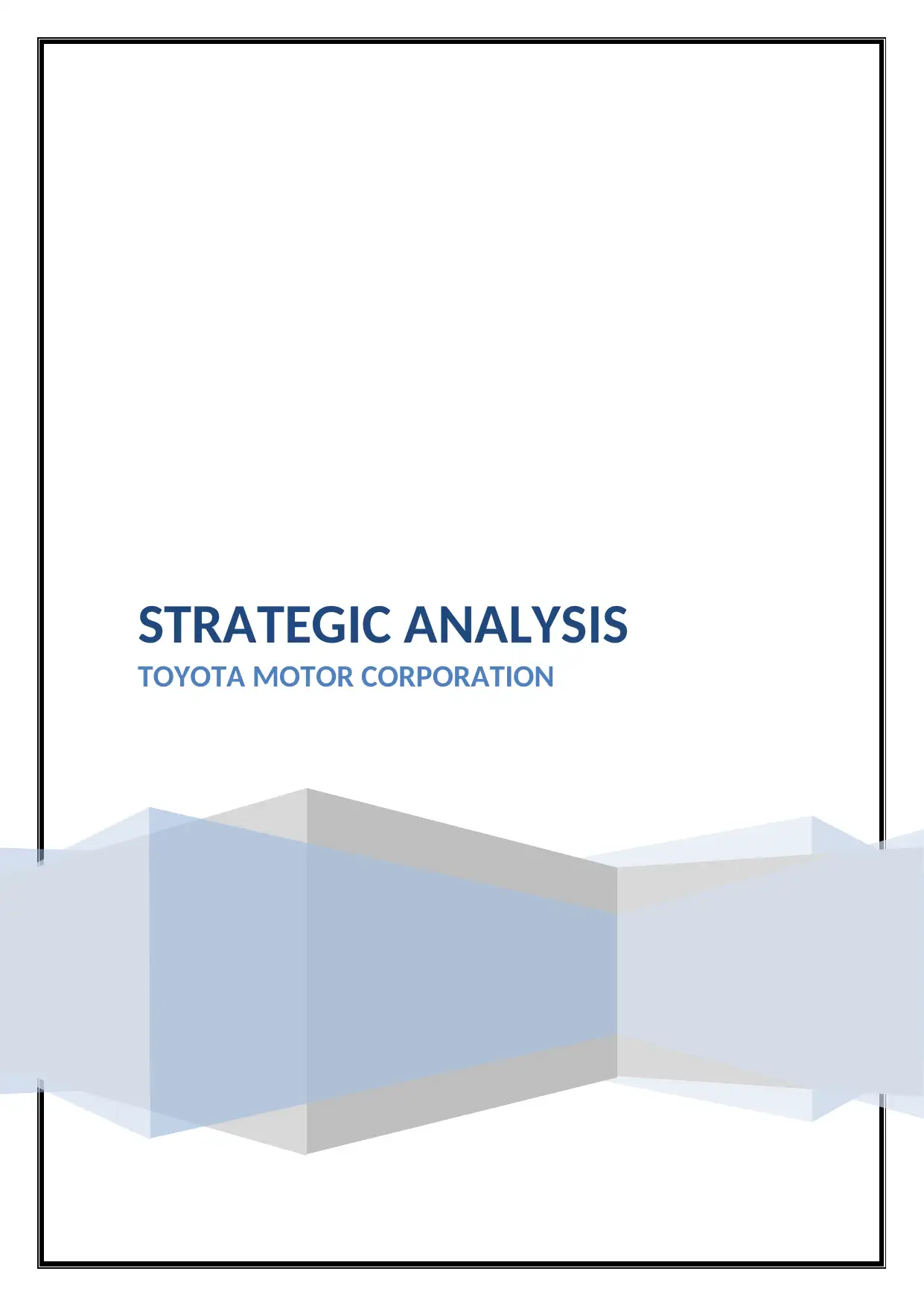
STRATEGIC ANALYSIS
TOYOTA MOTOR CORPORATION
TOYOTA MOTOR CORPORATION
Paraphrase This Document
Need a fresh take? Get an instant paraphrase of this document with our AI Paraphraser
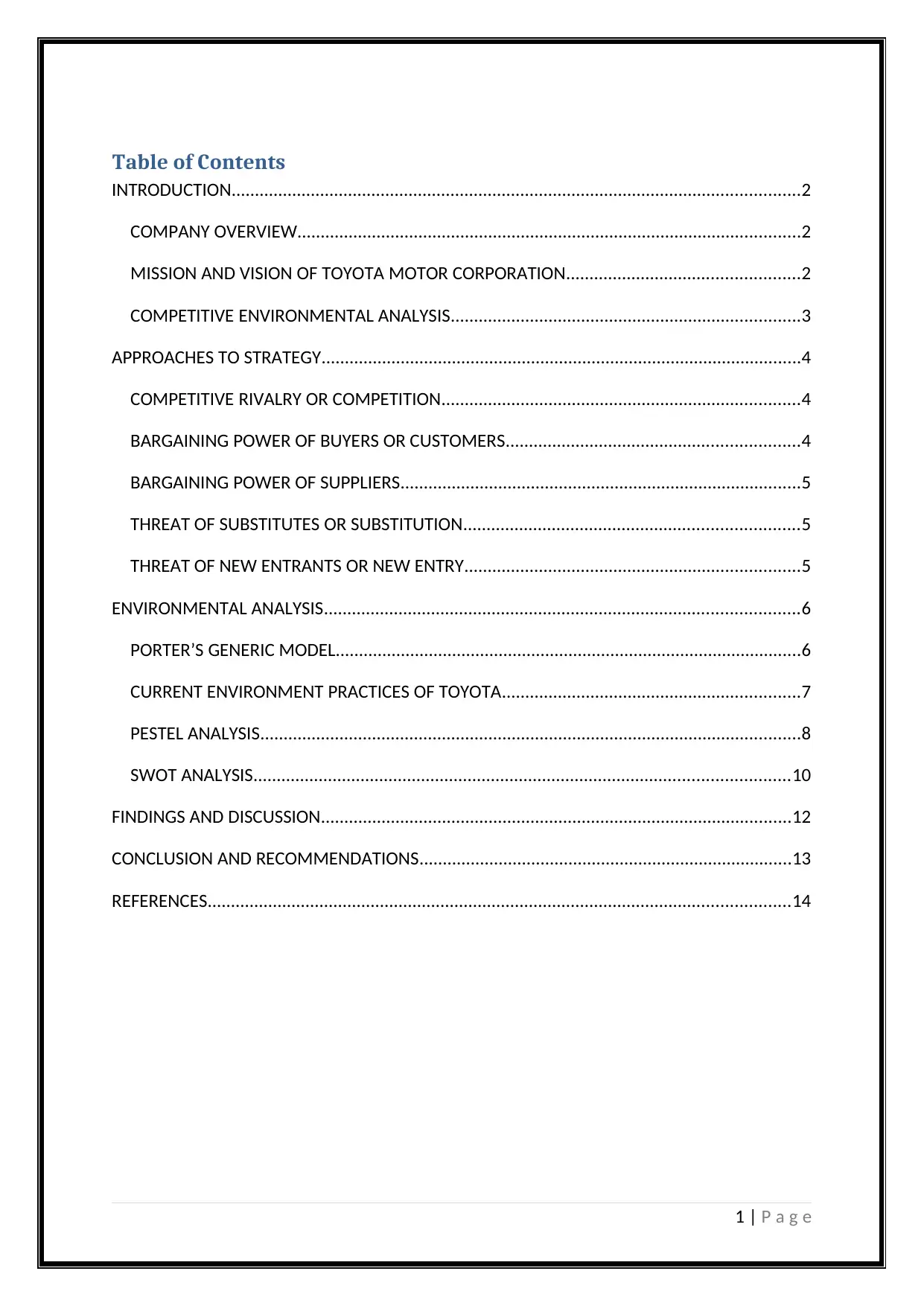
Table of Contents
INTRODUCTION..........................................................................................................................2
COMPANY OVERVIEW............................................................................................................2
MISSION AND VISION OF TOYOTA MOTOR CORPORATION..................................................2
COMPETITIVE ENVIRONMENTAL ANALYSIS...........................................................................3
APPROACHES TO STRATEGY.......................................................................................................4
COMPETITIVE RIVALRY OR COMPETITION.............................................................................4
BARGAINING POWER OF BUYERS OR CUSTOMERS...............................................................4
BARGAINING POWER OF SUPPLIERS......................................................................................5
THREAT OF SUBSTITUTES OR SUBSTITUTION........................................................................5
THREAT OF NEW ENTRANTS OR NEW ENTRY........................................................................5
ENVIRONMENTAL ANALYSIS......................................................................................................6
PORTER’S GENERIC MODEL....................................................................................................6
CURRENT ENVIRONMENT PRACTICES OF TOYOTA................................................................7
PESTEL ANALYSIS....................................................................................................................8
SWOT ANALYSIS...................................................................................................................10
FINDINGS AND DISCUSSION.....................................................................................................12
CONCLUSION AND RECOMMENDATIONS................................................................................13
REFERENCES.............................................................................................................................14
1 | P a g e
INTRODUCTION..........................................................................................................................2
COMPANY OVERVIEW............................................................................................................2
MISSION AND VISION OF TOYOTA MOTOR CORPORATION..................................................2
COMPETITIVE ENVIRONMENTAL ANALYSIS...........................................................................3
APPROACHES TO STRATEGY.......................................................................................................4
COMPETITIVE RIVALRY OR COMPETITION.............................................................................4
BARGAINING POWER OF BUYERS OR CUSTOMERS...............................................................4
BARGAINING POWER OF SUPPLIERS......................................................................................5
THREAT OF SUBSTITUTES OR SUBSTITUTION........................................................................5
THREAT OF NEW ENTRANTS OR NEW ENTRY........................................................................5
ENVIRONMENTAL ANALYSIS......................................................................................................6
PORTER’S GENERIC MODEL....................................................................................................6
CURRENT ENVIRONMENT PRACTICES OF TOYOTA................................................................7
PESTEL ANALYSIS....................................................................................................................8
SWOT ANALYSIS...................................................................................................................10
FINDINGS AND DISCUSSION.....................................................................................................12
CONCLUSION AND RECOMMENDATIONS................................................................................13
REFERENCES.............................................................................................................................14
1 | P a g e
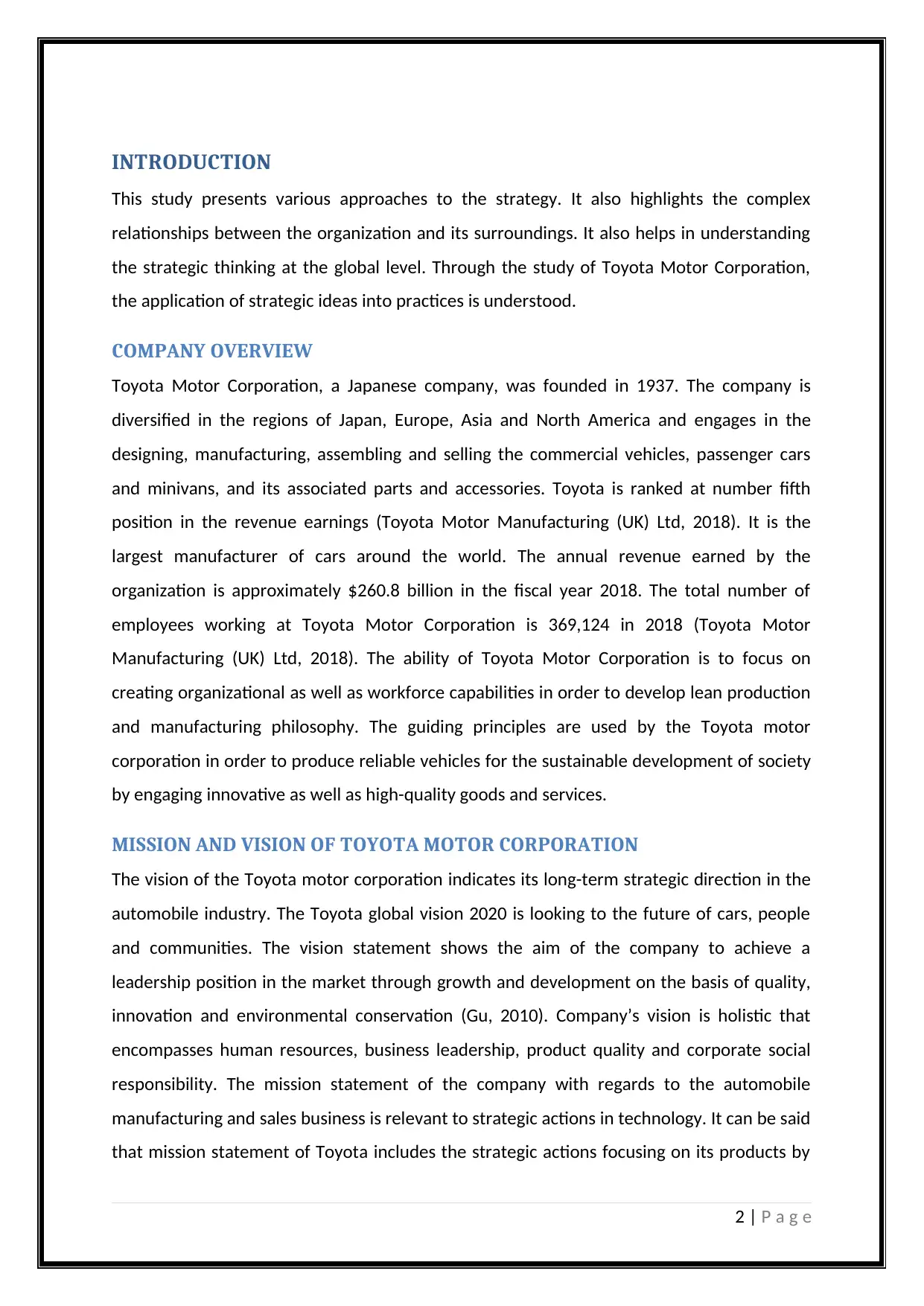
INTRODUCTION
This study presents various approaches to the strategy. It also highlights the complex
relationships between the organization and its surroundings. It also helps in understanding
the strategic thinking at the global level. Through the study of Toyota Motor Corporation,
the application of strategic ideas into practices is understood.
COMPANY OVERVIEW
Toyota Motor Corporation, a Japanese company, was founded in 1937. The company is
diversified in the regions of Japan, Europe, Asia and North America and engages in the
designing, manufacturing, assembling and selling the commercial vehicles, passenger cars
and minivans, and its associated parts and accessories. Toyota is ranked at number fifth
position in the revenue earnings (Toyota Motor Manufacturing (UK) Ltd, 2018). It is the
largest manufacturer of cars around the world. The annual revenue earned by the
organization is approximately $260.8 billion in the fiscal year 2018. The total number of
employees working at Toyota Motor Corporation is 369,124 in 2018 (Toyota Motor
Manufacturing (UK) Ltd, 2018). The ability of Toyota Motor Corporation is to focus on
creating organizational as well as workforce capabilities in order to develop lean production
and manufacturing philosophy. The guiding principles are used by the Toyota motor
corporation in order to produce reliable vehicles for the sustainable development of society
by engaging innovative as well as high-quality goods and services.
MISSION AND VISION OF TOYOTA MOTOR CORPORATION
The vision of the Toyota motor corporation indicates its long-term strategic direction in the
automobile industry. The Toyota global vision 2020 is looking to the future of cars, people
and communities. The vision statement shows the aim of the company to achieve a
leadership position in the market through growth and development on the basis of quality,
innovation and environmental conservation (Gu, 2010). Company’s vision is holistic that
encompasses human resources, business leadership, product quality and corporate social
responsibility. The mission statement of the company with regards to the automobile
manufacturing and sales business is relevant to strategic actions in technology. It can be said
that mission statement of Toyota includes the strategic actions focusing on its products by
2 | P a g e
This study presents various approaches to the strategy. It also highlights the complex
relationships between the organization and its surroundings. It also helps in understanding
the strategic thinking at the global level. Through the study of Toyota Motor Corporation,
the application of strategic ideas into practices is understood.
COMPANY OVERVIEW
Toyota Motor Corporation, a Japanese company, was founded in 1937. The company is
diversified in the regions of Japan, Europe, Asia and North America and engages in the
designing, manufacturing, assembling and selling the commercial vehicles, passenger cars
and minivans, and its associated parts and accessories. Toyota is ranked at number fifth
position in the revenue earnings (Toyota Motor Manufacturing (UK) Ltd, 2018). It is the
largest manufacturer of cars around the world. The annual revenue earned by the
organization is approximately $260.8 billion in the fiscal year 2018. The total number of
employees working at Toyota Motor Corporation is 369,124 in 2018 (Toyota Motor
Manufacturing (UK) Ltd, 2018). The ability of Toyota Motor Corporation is to focus on
creating organizational as well as workforce capabilities in order to develop lean production
and manufacturing philosophy. The guiding principles are used by the Toyota motor
corporation in order to produce reliable vehicles for the sustainable development of society
by engaging innovative as well as high-quality goods and services.
MISSION AND VISION OF TOYOTA MOTOR CORPORATION
The vision of the Toyota motor corporation indicates its long-term strategic direction in the
automobile industry. The Toyota global vision 2020 is looking to the future of cars, people
and communities. The vision statement shows the aim of the company to achieve a
leadership position in the market through growth and development on the basis of quality,
innovation and environmental conservation (Gu, 2010). Company’s vision is holistic that
encompasses human resources, business leadership, product quality and corporate social
responsibility. The mission statement of the company with regards to the automobile
manufacturing and sales business is relevant to strategic actions in technology. It can be said
that mission statement of Toyota includes the strategic actions focusing on its products by
2 | P a g e
⊘ This is a preview!⊘
Do you want full access?
Subscribe today to unlock all pages.

Trusted by 1+ million students worldwide
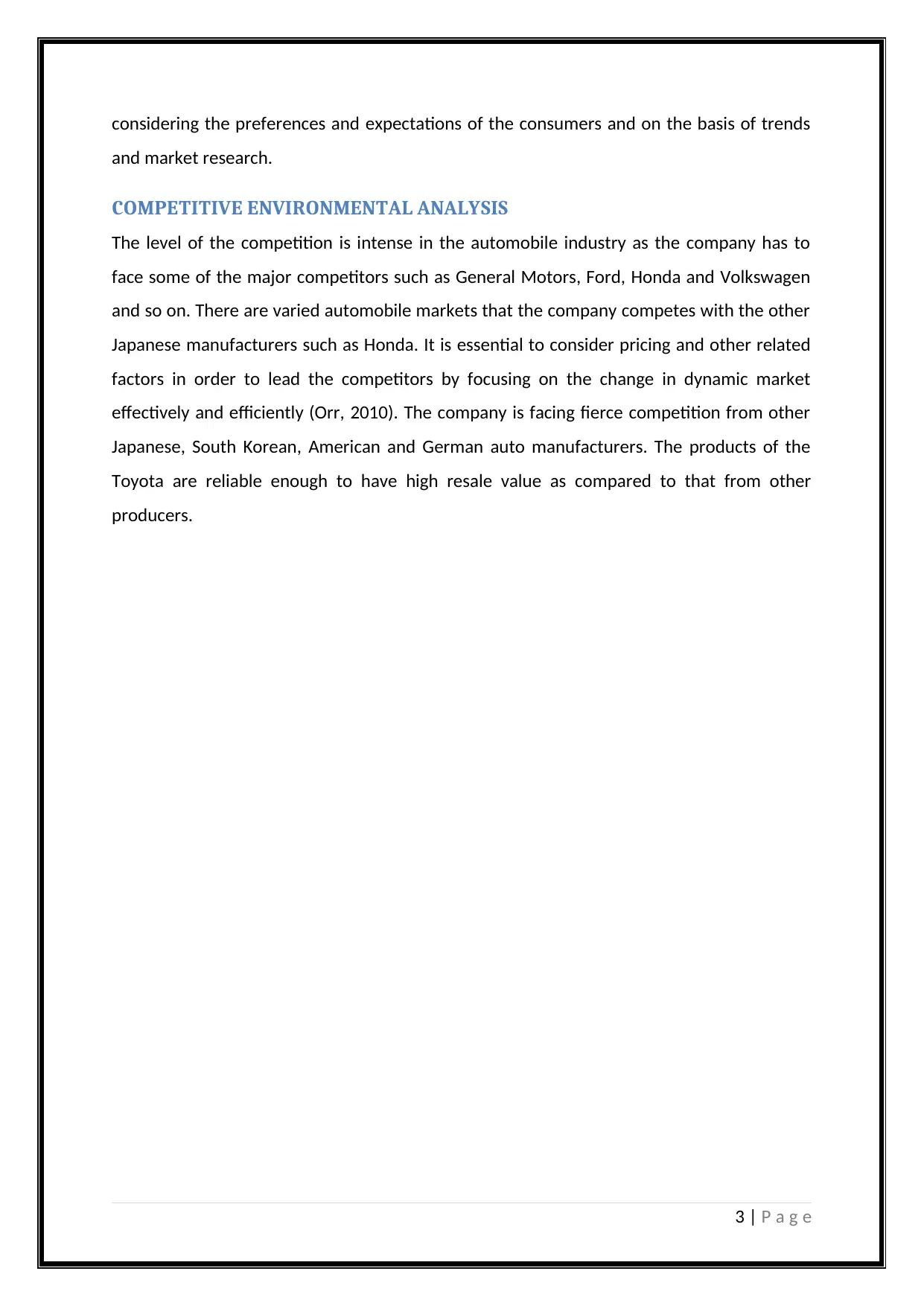
considering the preferences and expectations of the consumers and on the basis of trends
and market research.
COMPETITIVE ENVIRONMENTAL ANALYSIS
The level of the competition is intense in the automobile industry as the company has to
face some of the major competitors such as General Motors, Ford, Honda and Volkswagen
and so on. There are varied automobile markets that the company competes with the other
Japanese manufacturers such as Honda. It is essential to consider pricing and other related
factors in order to lead the competitors by focusing on the change in dynamic market
effectively and efficiently (Orr, 2010). The company is facing fierce competition from other
Japanese, South Korean, American and German auto manufacturers. The products of the
Toyota are reliable enough to have high resale value as compared to that from other
producers.
3 | P a g e
and market research.
COMPETITIVE ENVIRONMENTAL ANALYSIS
The level of the competition is intense in the automobile industry as the company has to
face some of the major competitors such as General Motors, Ford, Honda and Volkswagen
and so on. There are varied automobile markets that the company competes with the other
Japanese manufacturers such as Honda. It is essential to consider pricing and other related
factors in order to lead the competitors by focusing on the change in dynamic market
effectively and efficiently (Orr, 2010). The company is facing fierce competition from other
Japanese, South Korean, American and German auto manufacturers. The products of the
Toyota are reliable enough to have high resale value as compared to that from other
producers.
3 | P a g e
Paraphrase This Document
Need a fresh take? Get an instant paraphrase of this document with our AI Paraphraser
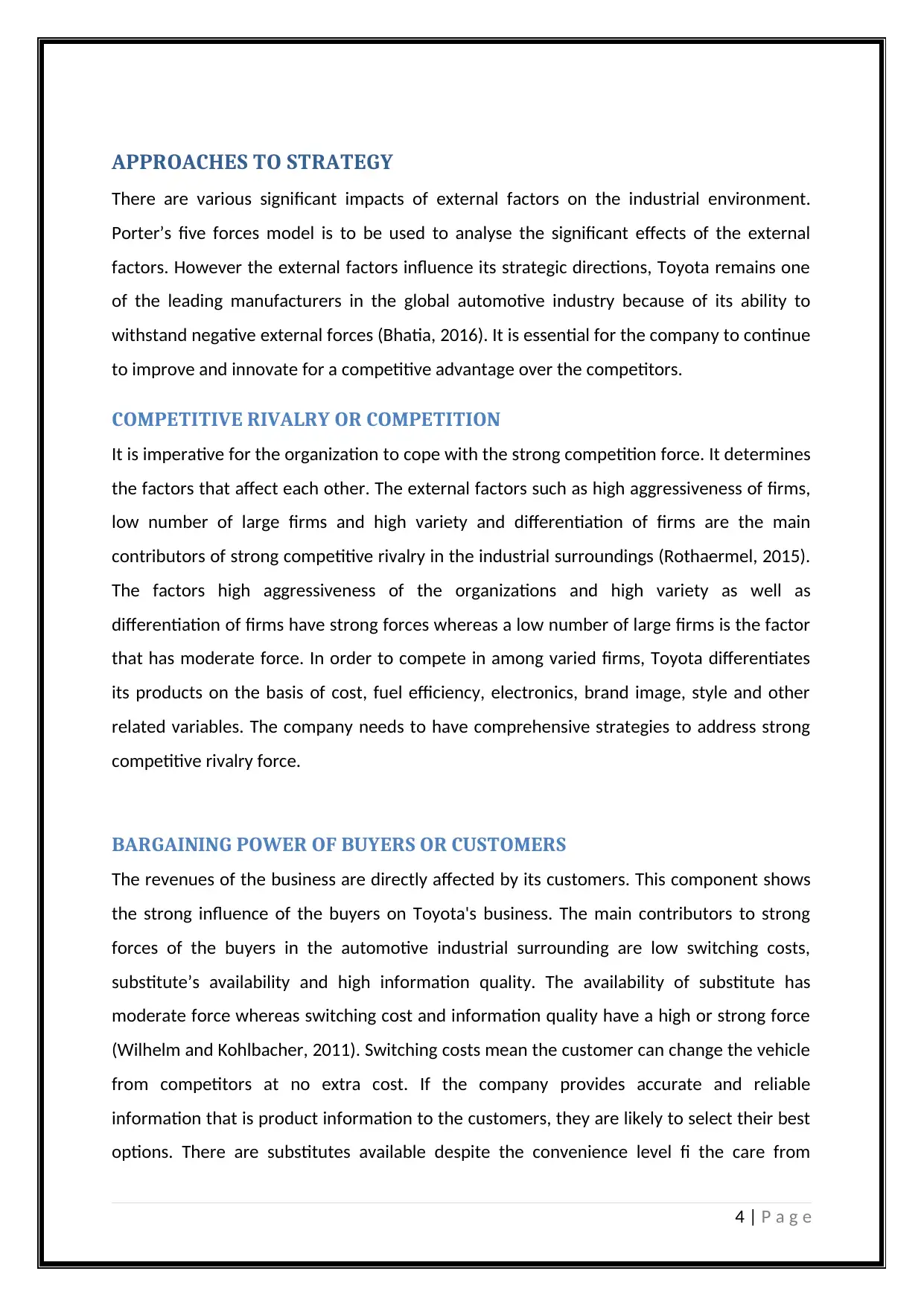
APPROACHES TO STRATEGY
There are various significant impacts of external factors on the industrial environment.
Porter’s five forces model is to be used to analyse the significant effects of the external
factors. However the external factors influence its strategic directions, Toyota remains one
of the leading manufacturers in the global automotive industry because of its ability to
withstand negative external forces (Bhatia, 2016). It is essential for the company to continue
to improve and innovate for a competitive advantage over the competitors.
COMPETITIVE RIVALRY OR COMPETITION
It is imperative for the organization to cope with the strong competition force. It determines
the factors that affect each other. The external factors such as high aggressiveness of firms,
low number of large firms and high variety and differentiation of firms are the main
contributors of strong competitive rivalry in the industrial surroundings (Rothaermel, 2015).
The factors high aggressiveness of the organizations and high variety as well as
differentiation of firms have strong forces whereas a low number of large firms is the factor
that has moderate force. In order to compete in among varied firms, Toyota differentiates
its products on the basis of cost, fuel efficiency, electronics, brand image, style and other
related variables. The company needs to have comprehensive strategies to address strong
competitive rivalry force.
BARGAINING POWER OF BUYERS OR CUSTOMERS
The revenues of the business are directly affected by its customers. This component shows
the strong influence of the buyers on Toyota's business. The main contributors to strong
forces of the buyers in the automotive industrial surrounding are low switching costs,
substitute’s availability and high information quality. The availability of substitute has
moderate force whereas switching cost and information quality have a high or strong force
(Wilhelm and Kohlbacher, 2011). Switching costs mean the customer can change the vehicle
from competitors at no extra cost. If the company provides accurate and reliable
information that is product information to the customers, they are likely to select their best
options. There are substitutes available despite the convenience level fi the care from
4 | P a g e
There are various significant impacts of external factors on the industrial environment.
Porter’s five forces model is to be used to analyse the significant effects of the external
factors. However the external factors influence its strategic directions, Toyota remains one
of the leading manufacturers in the global automotive industry because of its ability to
withstand negative external forces (Bhatia, 2016). It is essential for the company to continue
to improve and innovate for a competitive advantage over the competitors.
COMPETITIVE RIVALRY OR COMPETITION
It is imperative for the organization to cope with the strong competition force. It determines
the factors that affect each other. The external factors such as high aggressiveness of firms,
low number of large firms and high variety and differentiation of firms are the main
contributors of strong competitive rivalry in the industrial surroundings (Rothaermel, 2015).
The factors high aggressiveness of the organizations and high variety as well as
differentiation of firms have strong forces whereas a low number of large firms is the factor
that has moderate force. In order to compete in among varied firms, Toyota differentiates
its products on the basis of cost, fuel efficiency, electronics, brand image, style and other
related variables. The company needs to have comprehensive strategies to address strong
competitive rivalry force.
BARGAINING POWER OF BUYERS OR CUSTOMERS
The revenues of the business are directly affected by its customers. This component shows
the strong influence of the buyers on Toyota's business. The main contributors to strong
forces of the buyers in the automotive industrial surrounding are low switching costs,
substitute’s availability and high information quality. The availability of substitute has
moderate force whereas switching cost and information quality have a high or strong force
(Wilhelm and Kohlbacher, 2011). Switching costs mean the customer can change the vehicle
from competitors at no extra cost. If the company provides accurate and reliable
information that is product information to the customers, they are likely to select their best
options. There are substitutes available despite the convenience level fi the care from
4 | P a g e
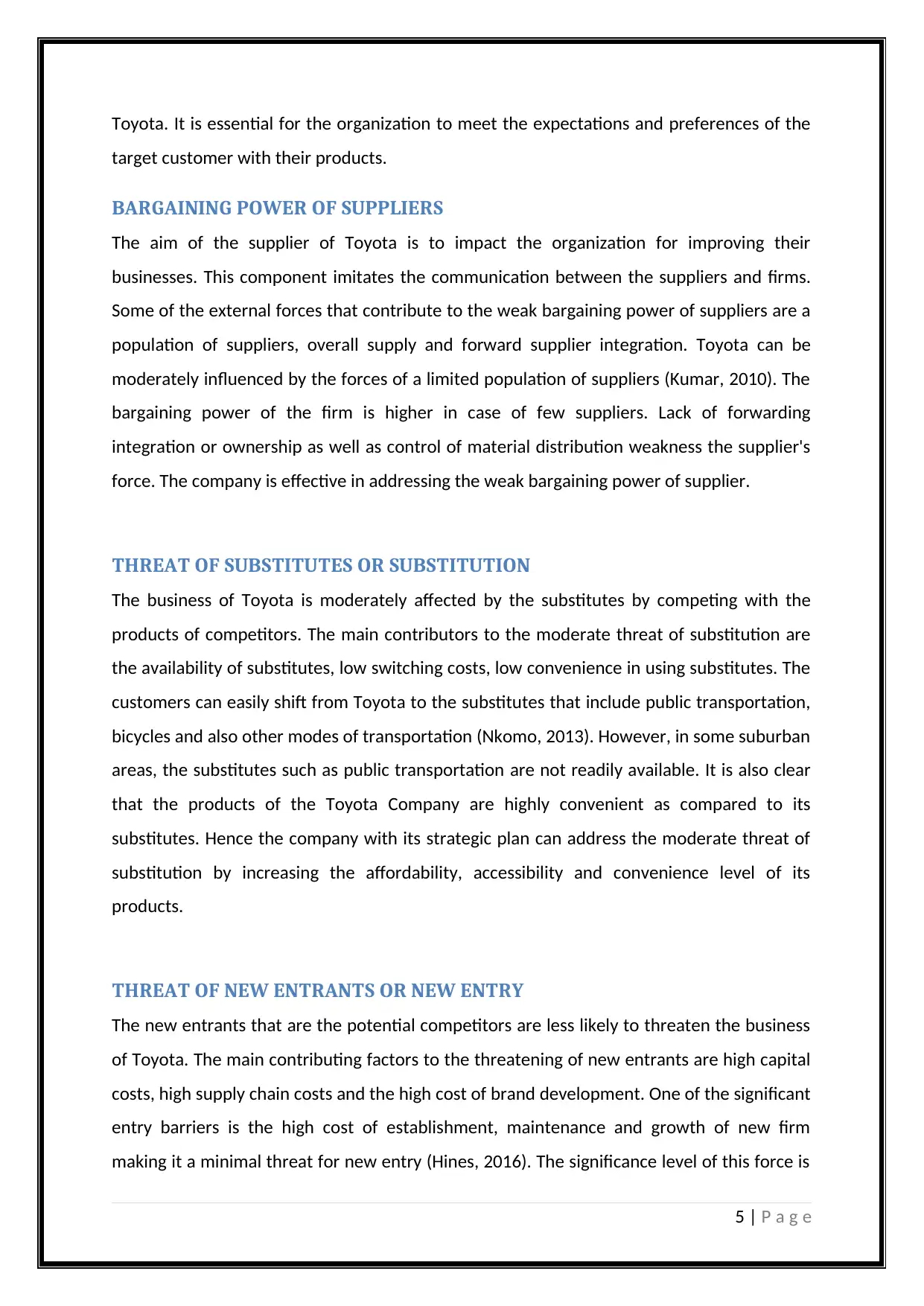
Toyota. It is essential for the organization to meet the expectations and preferences of the
target customer with their products.
BARGAINING POWER OF SUPPLIERS
The aim of the supplier of Toyota is to impact the organization for improving their
businesses. This component imitates the communication between the suppliers and firms.
Some of the external forces that contribute to the weak bargaining power of suppliers are a
population of suppliers, overall supply and forward supplier integration. Toyota can be
moderately influenced by the forces of a limited population of suppliers (Kumar, 2010). The
bargaining power of the firm is higher in case of few suppliers. Lack of forwarding
integration or ownership as well as control of material distribution weakness the supplier's
force. The company is effective in addressing the weak bargaining power of supplier.
THREAT OF SUBSTITUTES OR SUBSTITUTION
The business of Toyota is moderately affected by the substitutes by competing with the
products of competitors. The main contributors to the moderate threat of substitution are
the availability of substitutes, low switching costs, low convenience in using substitutes. The
customers can easily shift from Toyota to the substitutes that include public transportation,
bicycles and also other modes of transportation (Nkomo, 2013). However, in some suburban
areas, the substitutes such as public transportation are not readily available. It is also clear
that the products of the Toyota Company are highly convenient as compared to its
substitutes. Hence the company with its strategic plan can address the moderate threat of
substitution by increasing the affordability, accessibility and convenience level of its
products.
THREAT OF NEW ENTRANTS OR NEW ENTRY
The new entrants that are the potential competitors are less likely to threaten the business
of Toyota. The main contributing factors to the threatening of new entrants are high capital
costs, high supply chain costs and the high cost of brand development. One of the significant
entry barriers is the high cost of establishment, maintenance and growth of new firm
making it a minimal threat for new entry (Hines, 2016). The significance level of this force is
5 | P a g e
target customer with their products.
BARGAINING POWER OF SUPPLIERS
The aim of the supplier of Toyota is to impact the organization for improving their
businesses. This component imitates the communication between the suppliers and firms.
Some of the external forces that contribute to the weak bargaining power of suppliers are a
population of suppliers, overall supply and forward supplier integration. Toyota can be
moderately influenced by the forces of a limited population of suppliers (Kumar, 2010). The
bargaining power of the firm is higher in case of few suppliers. Lack of forwarding
integration or ownership as well as control of material distribution weakness the supplier's
force. The company is effective in addressing the weak bargaining power of supplier.
THREAT OF SUBSTITUTES OR SUBSTITUTION
The business of Toyota is moderately affected by the substitutes by competing with the
products of competitors. The main contributors to the moderate threat of substitution are
the availability of substitutes, low switching costs, low convenience in using substitutes. The
customers can easily shift from Toyota to the substitutes that include public transportation,
bicycles and also other modes of transportation (Nkomo, 2013). However, in some suburban
areas, the substitutes such as public transportation are not readily available. It is also clear
that the products of the Toyota Company are highly convenient as compared to its
substitutes. Hence the company with its strategic plan can address the moderate threat of
substitution by increasing the affordability, accessibility and convenience level of its
products.
THREAT OF NEW ENTRANTS OR NEW ENTRY
The new entrants that are the potential competitors are less likely to threaten the business
of Toyota. The main contributing factors to the threatening of new entrants are high capital
costs, high supply chain costs and the high cost of brand development. One of the significant
entry barriers is the high cost of establishment, maintenance and growth of new firm
making it a minimal threat for new entry (Hines, 2016). The significance level of this force is
5 | P a g e
⊘ This is a preview!⊘
Do you want full access?
Subscribe today to unlock all pages.

Trusted by 1+ million students worldwide
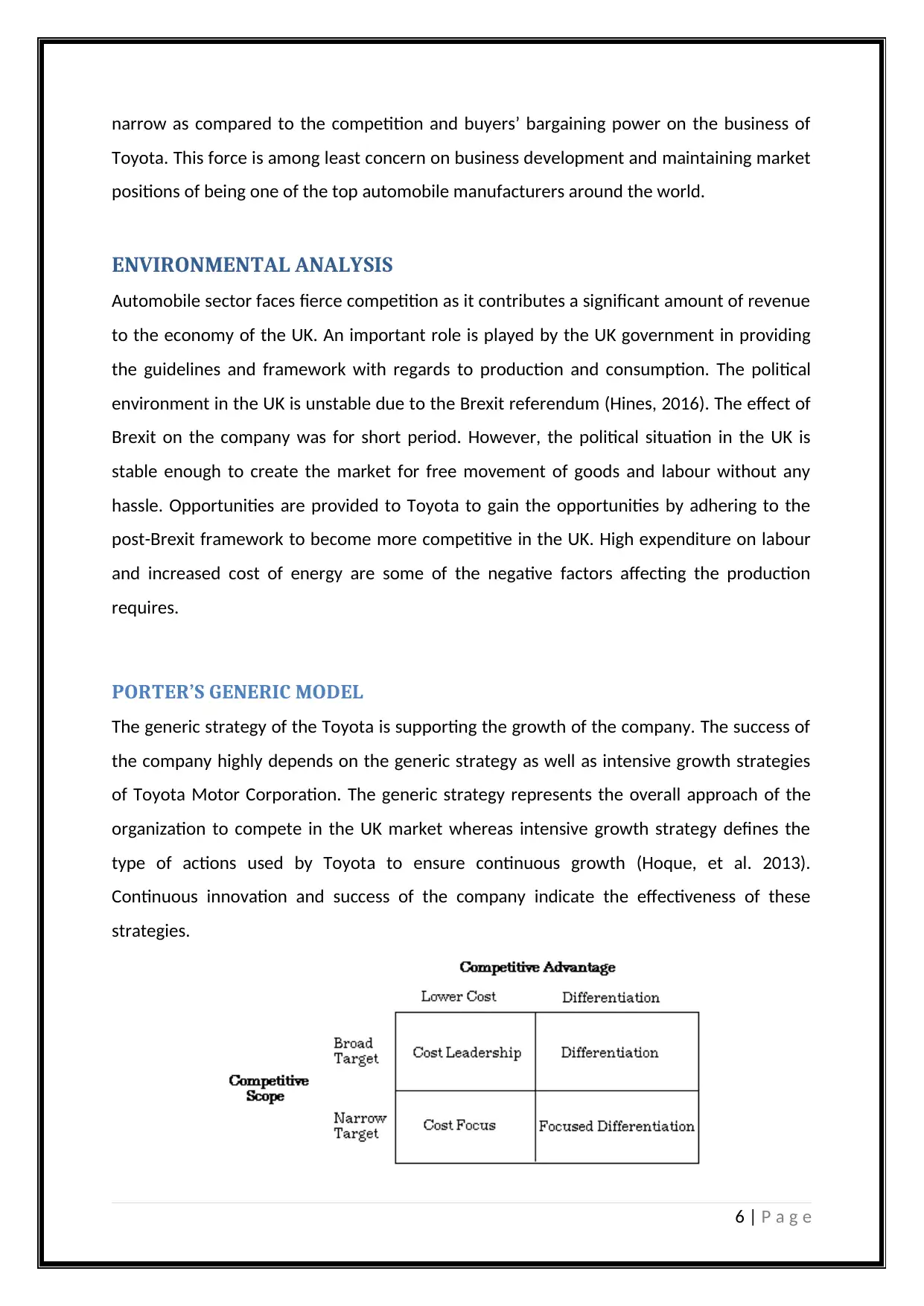
narrow as compared to the competition and buyers’ bargaining power on the business of
Toyota. This force is among least concern on business development and maintaining market
positions of being one of the top automobile manufacturers around the world.
ENVIRONMENTAL ANALYSIS
Automobile sector faces fierce competition as it contributes a significant amount of revenue
to the economy of the UK. An important role is played by the UK government in providing
the guidelines and framework with regards to production and consumption. The political
environment in the UK is unstable due to the Brexit referendum (Hines, 2016). The effect of
Brexit on the company was for short period. However, the political situation in the UK is
stable enough to create the market for free movement of goods and labour without any
hassle. Opportunities are provided to Toyota to gain the opportunities by adhering to the
post-Brexit framework to become more competitive in the UK. High expenditure on labour
and increased cost of energy are some of the negative factors affecting the production
requires.
PORTER’S GENERIC MODEL
The generic strategy of the Toyota is supporting the growth of the company. The success of
the company highly depends on the generic strategy as well as intensive growth strategies
of Toyota Motor Corporation. The generic strategy represents the overall approach of the
organization to compete in the UK market whereas intensive growth strategy defines the
type of actions used by Toyota to ensure continuous growth (Hoque, et al. 2013).
Continuous innovation and success of the company indicate the effectiveness of these
strategies.
6 | P a g e
Toyota. This force is among least concern on business development and maintaining market
positions of being one of the top automobile manufacturers around the world.
ENVIRONMENTAL ANALYSIS
Automobile sector faces fierce competition as it contributes a significant amount of revenue
to the economy of the UK. An important role is played by the UK government in providing
the guidelines and framework with regards to production and consumption. The political
environment in the UK is unstable due to the Brexit referendum (Hines, 2016). The effect of
Brexit on the company was for short period. However, the political situation in the UK is
stable enough to create the market for free movement of goods and labour without any
hassle. Opportunities are provided to Toyota to gain the opportunities by adhering to the
post-Brexit framework to become more competitive in the UK. High expenditure on labour
and increased cost of energy are some of the negative factors affecting the production
requires.
PORTER’S GENERIC MODEL
The generic strategy of the Toyota is supporting the growth of the company. The success of
the company highly depends on the generic strategy as well as intensive growth strategies
of Toyota Motor Corporation. The generic strategy represents the overall approach of the
organization to compete in the UK market whereas intensive growth strategy defines the
type of actions used by Toyota to ensure continuous growth (Hoque, et al. 2013).
Continuous innovation and success of the company indicate the effectiveness of these
strategies.
6 | P a g e
Paraphrase This Document
Need a fresh take? Get an instant paraphrase of this document with our AI Paraphraser
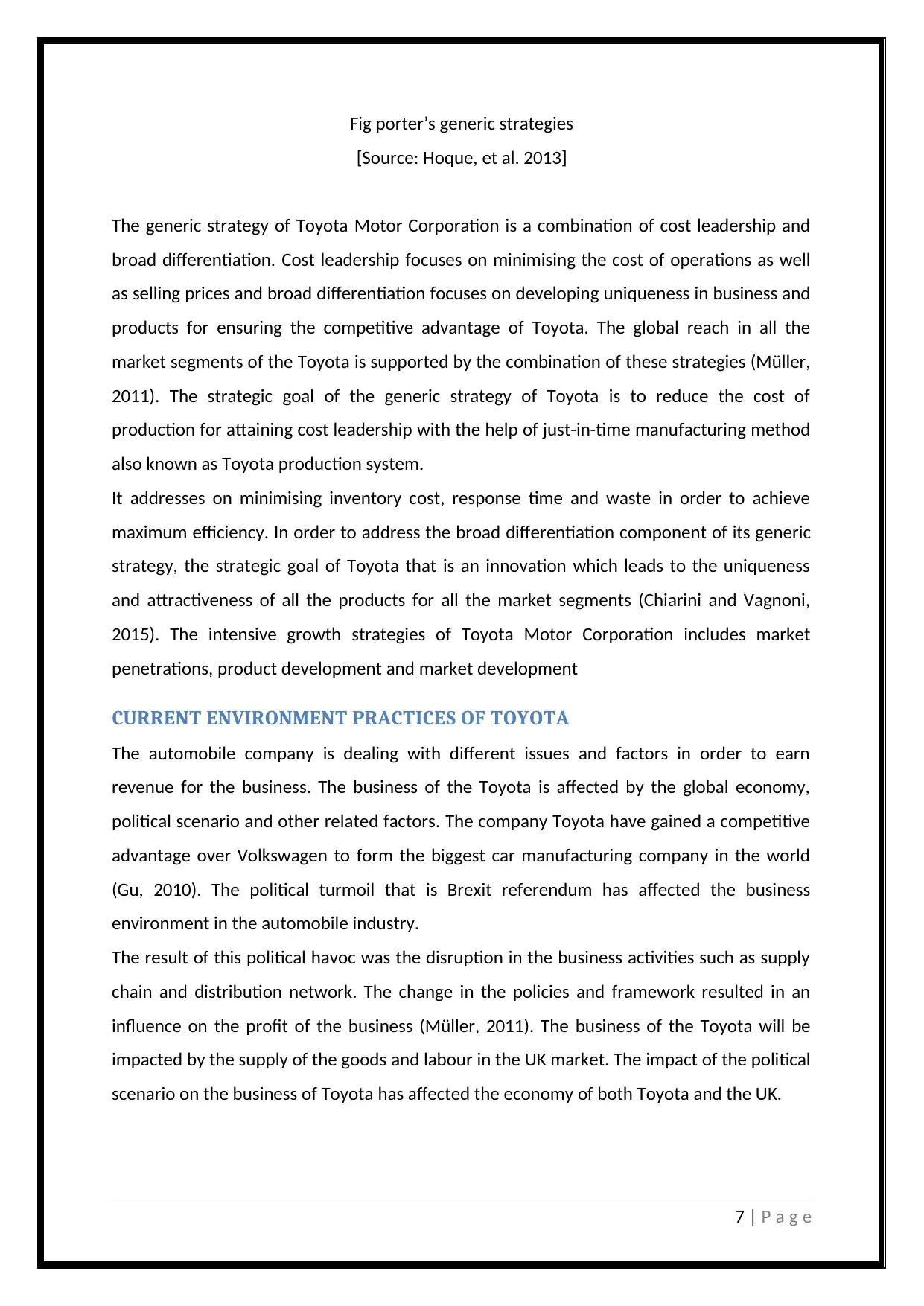
Fig porter’s generic strategies
[Source: Hoque, et al. 2013]
The generic strategy of Toyota Motor Corporation is a combination of cost leadership and
broad differentiation. Cost leadership focuses on minimising the cost of operations as well
as selling prices and broad differentiation focuses on developing uniqueness in business and
products for ensuring the competitive advantage of Toyota. The global reach in all the
market segments of the Toyota is supported by the combination of these strategies (Müller,
2011). The strategic goal of the generic strategy of Toyota is to reduce the cost of
production for attaining cost leadership with the help of just-in-time manufacturing method
also known as Toyota production system.
It addresses on minimising inventory cost, response time and waste in order to achieve
maximum efficiency. In order to address the broad differentiation component of its generic
strategy, the strategic goal of Toyota that is an innovation which leads to the uniqueness
and attractiveness of all the products for all the market segments (Chiarini and Vagnoni,
2015). The intensive growth strategies of Toyota Motor Corporation includes market
penetrations, product development and market development
CURRENT ENVIRONMENT PRACTICES OF TOYOTA
The automobile company is dealing with different issues and factors in order to earn
revenue for the business. The business of the Toyota is affected by the global economy,
political scenario and other related factors. The company Toyota have gained a competitive
advantage over Volkswagen to form the biggest car manufacturing company in the world
(Gu, 2010). The political turmoil that is Brexit referendum has affected the business
environment in the automobile industry.
The result of this political havoc was the disruption in the business activities such as supply
chain and distribution network. The change in the policies and framework resulted in an
influence on the profit of the business (Müller, 2011). The business of the Toyota will be
impacted by the supply of the goods and labour in the UK market. The impact of the political
scenario on the business of Toyota has affected the economy of both Toyota and the UK.
7 | P a g e
[Source: Hoque, et al. 2013]
The generic strategy of Toyota Motor Corporation is a combination of cost leadership and
broad differentiation. Cost leadership focuses on minimising the cost of operations as well
as selling prices and broad differentiation focuses on developing uniqueness in business and
products for ensuring the competitive advantage of Toyota. The global reach in all the
market segments of the Toyota is supported by the combination of these strategies (Müller,
2011). The strategic goal of the generic strategy of Toyota is to reduce the cost of
production for attaining cost leadership with the help of just-in-time manufacturing method
also known as Toyota production system.
It addresses on minimising inventory cost, response time and waste in order to achieve
maximum efficiency. In order to address the broad differentiation component of its generic
strategy, the strategic goal of Toyota that is an innovation which leads to the uniqueness
and attractiveness of all the products for all the market segments (Chiarini and Vagnoni,
2015). The intensive growth strategies of Toyota Motor Corporation includes market
penetrations, product development and market development
CURRENT ENVIRONMENT PRACTICES OF TOYOTA
The automobile company is dealing with different issues and factors in order to earn
revenue for the business. The business of the Toyota is affected by the global economy,
political scenario and other related factors. The company Toyota have gained a competitive
advantage over Volkswagen to form the biggest car manufacturing company in the world
(Gu, 2010). The political turmoil that is Brexit referendum has affected the business
environment in the automobile industry.
The result of this political havoc was the disruption in the business activities such as supply
chain and distribution network. The change in the policies and framework resulted in an
influence on the profit of the business (Müller, 2011). The business of the Toyota will be
impacted by the supply of the goods and labour in the UK market. The impact of the political
scenario on the business of Toyota has affected the economy of both Toyota and the UK.
7 | P a g e
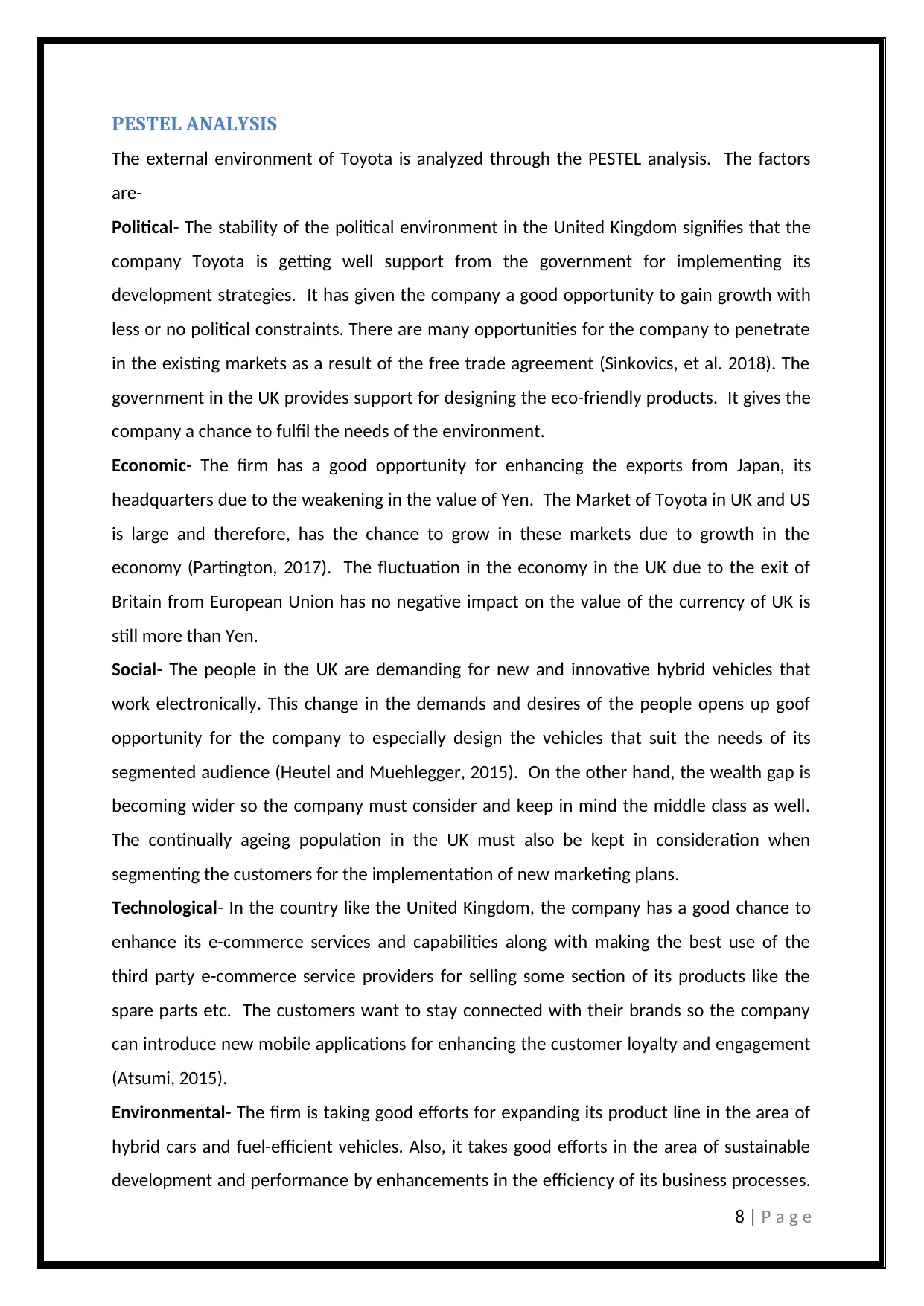
PESTEL ANALYSIS
The external environment of Toyota is analyzed through the PESTEL analysis. The factors
are-
Political- The stability of the political environment in the United Kingdom signifies that the
company Toyota is getting well support from the government for implementing its
development strategies. It has given the company a good opportunity to gain growth with
less or no political constraints. There are many opportunities for the company to penetrate
in the existing markets as a result of the free trade agreement (Sinkovics, et al. 2018). The
government in the UK provides support for designing the eco-friendly products. It gives the
company a chance to fulfil the needs of the environment.
Economic- The firm has a good opportunity for enhancing the exports from Japan, its
headquarters due to the weakening in the value of Yen. The Market of Toyota in UK and US
is large and therefore, has the chance to grow in these markets due to growth in the
economy (Partington, 2017). The fluctuation in the economy in the UK due to the exit of
Britain from European Union has no negative impact on the value of the currency of UK is
still more than Yen.
Social- The people in the UK are demanding for new and innovative hybrid vehicles that
work electronically. This change in the demands and desires of the people opens up goof
opportunity for the company to especially design the vehicles that suit the needs of its
segmented audience (Heutel and Muehlegger, 2015). On the other hand, the wealth gap is
becoming wider so the company must consider and keep in mind the middle class as well.
The continually ageing population in the UK must also be kept in consideration when
segmenting the customers for the implementation of new marketing plans.
Technological- In the country like the United Kingdom, the company has a good chance to
enhance its e-commerce services and capabilities along with making the best use of the
third party e-commerce service providers for selling some section of its products like the
spare parts etc. The customers want to stay connected with their brands so the company
can introduce new mobile applications for enhancing the customer loyalty and engagement
(Atsumi, 2015).
Environmental- The firm is taking good efforts for expanding its product line in the area of
hybrid cars and fuel-efficient vehicles. Also, it takes good efforts in the area of sustainable
development and performance by enhancements in the efficiency of its business processes.
8 | P a g e
The external environment of Toyota is analyzed through the PESTEL analysis. The factors
are-
Political- The stability of the political environment in the United Kingdom signifies that the
company Toyota is getting well support from the government for implementing its
development strategies. It has given the company a good opportunity to gain growth with
less or no political constraints. There are many opportunities for the company to penetrate
in the existing markets as a result of the free trade agreement (Sinkovics, et al. 2018). The
government in the UK provides support for designing the eco-friendly products. It gives the
company a chance to fulfil the needs of the environment.
Economic- The firm has a good opportunity for enhancing the exports from Japan, its
headquarters due to the weakening in the value of Yen. The Market of Toyota in UK and US
is large and therefore, has the chance to grow in these markets due to growth in the
economy (Partington, 2017). The fluctuation in the economy in the UK due to the exit of
Britain from European Union has no negative impact on the value of the currency of UK is
still more than Yen.
Social- The people in the UK are demanding for new and innovative hybrid vehicles that
work electronically. This change in the demands and desires of the people opens up goof
opportunity for the company to especially design the vehicles that suit the needs of its
segmented audience (Heutel and Muehlegger, 2015). On the other hand, the wealth gap is
becoming wider so the company must consider and keep in mind the middle class as well.
The continually ageing population in the UK must also be kept in consideration when
segmenting the customers for the implementation of new marketing plans.
Technological- In the country like the United Kingdom, the company has a good chance to
enhance its e-commerce services and capabilities along with making the best use of the
third party e-commerce service providers for selling some section of its products like the
spare parts etc. The customers want to stay connected with their brands so the company
can introduce new mobile applications for enhancing the customer loyalty and engagement
(Atsumi, 2015).
Environmental- The firm is taking good efforts for expanding its product line in the area of
hybrid cars and fuel-efficient vehicles. Also, it takes good efforts in the area of sustainable
development and performance by enhancements in the efficiency of its business processes.
8 | P a g e
⊘ This is a preview!⊘
Do you want full access?
Subscribe today to unlock all pages.

Trusted by 1+ million students worldwide
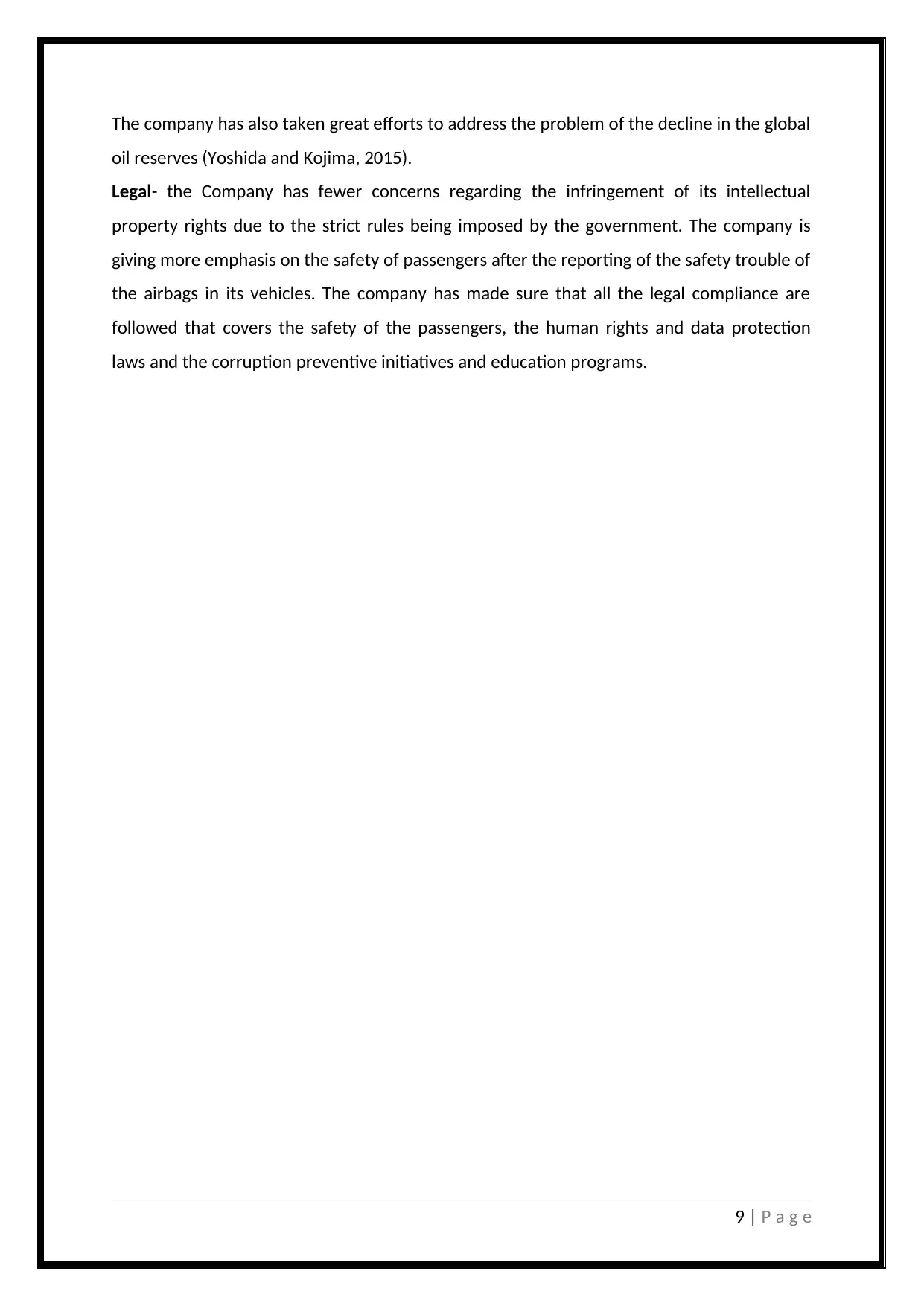
The company has also taken great efforts to address the problem of the decline in the global
oil reserves (Yoshida and Kojima, 2015).
Legal- the Company has fewer concerns regarding the infringement of its intellectual
property rights due to the strict rules being imposed by the government. The company is
giving more emphasis on the safety of passengers after the reporting of the safety trouble of
the airbags in its vehicles. The company has made sure that all the legal compliance are
followed that covers the safety of the passengers, the human rights and data protection
laws and the corruption preventive initiatives and education programs.
9 | P a g e
oil reserves (Yoshida and Kojima, 2015).
Legal- the Company has fewer concerns regarding the infringement of its intellectual
property rights due to the strict rules being imposed by the government. The company is
giving more emphasis on the safety of passengers after the reporting of the safety trouble of
the airbags in its vehicles. The company has made sure that all the legal compliance are
followed that covers the safety of the passengers, the human rights and data protection
laws and the corruption preventive initiatives and education programs.
9 | P a g e
Paraphrase This Document
Need a fresh take? Get an instant paraphrase of this document with our AI Paraphraser
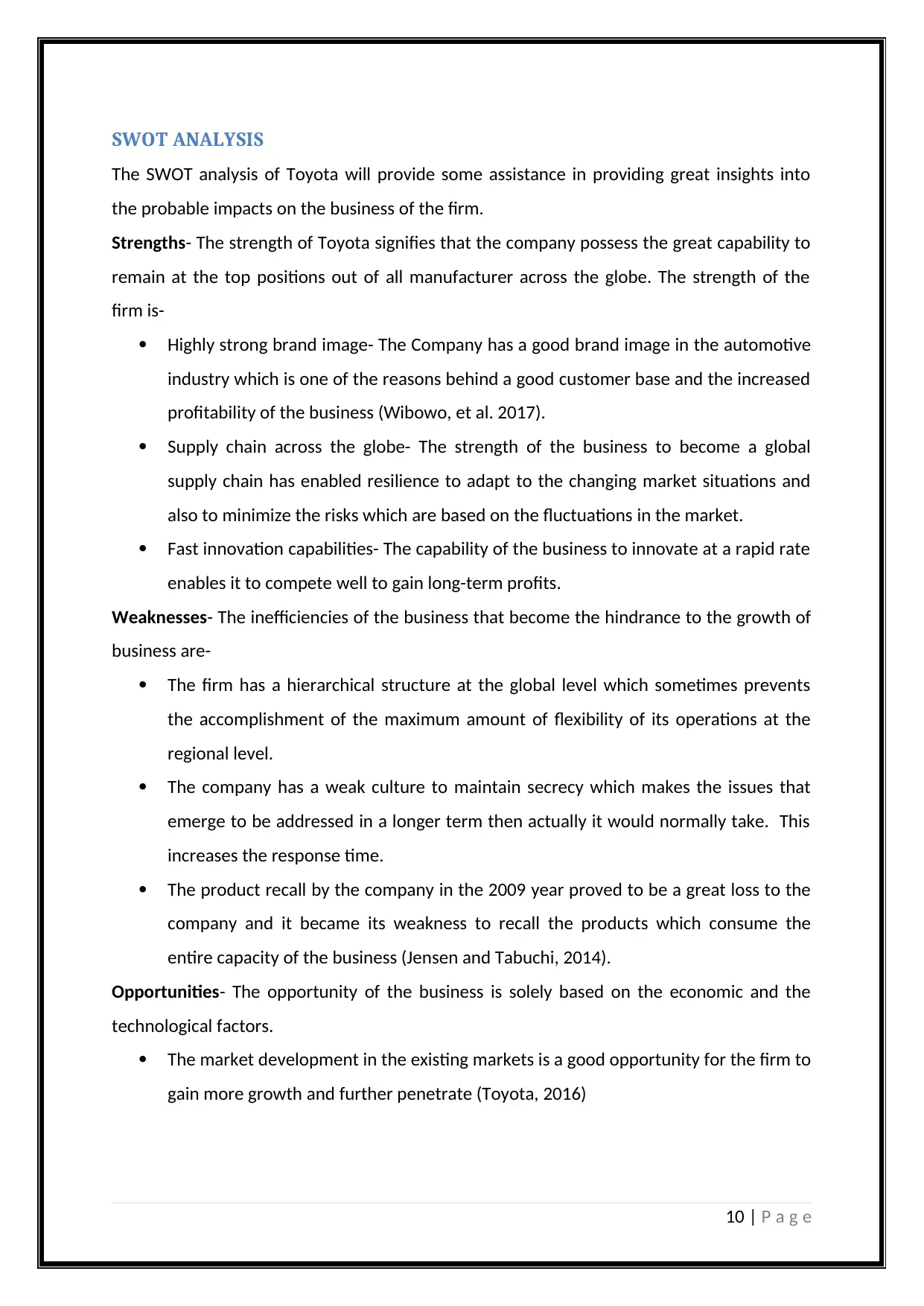
SWOT ANALYSIS
The SWOT analysis of Toyota will provide some assistance in providing great insights into
the probable impacts on the business of the firm.
Strengths- The strength of Toyota signifies that the company possess the great capability to
remain at the top positions out of all manufacturer across the globe. The strength of the
firm is-
Highly strong brand image- The Company has a good brand image in the automotive
industry which is one of the reasons behind a good customer base and the increased
profitability of the business (Wibowo, et al. 2017).
Supply chain across the globe- The strength of the business to become a global
supply chain has enabled resilience to adapt to the changing market situations and
also to minimize the risks which are based on the fluctuations in the market.
Fast innovation capabilities- The capability of the business to innovate at a rapid rate
enables it to compete well to gain long-term profits.
Weaknesses- The inefficiencies of the business that become the hindrance to the growth of
business are-
The firm has a hierarchical structure at the global level which sometimes prevents
the accomplishment of the maximum amount of flexibility of its operations at the
regional level.
The company has a weak culture to maintain secrecy which makes the issues that
emerge to be addressed in a longer term then actually it would normally take. This
increases the response time.
The product recall by the company in the 2009 year proved to be a great loss to the
company and it became its weakness to recall the products which consume the
entire capacity of the business (Jensen and Tabuchi, 2014).
Opportunities- The opportunity of the business is solely based on the economic and the
technological factors.
The market development in the existing markets is a good opportunity for the firm to
gain more growth and further penetrate (Toyota, 2016)
10 | P a g e
The SWOT analysis of Toyota will provide some assistance in providing great insights into
the probable impacts on the business of the firm.
Strengths- The strength of Toyota signifies that the company possess the great capability to
remain at the top positions out of all manufacturer across the globe. The strength of the
firm is-
Highly strong brand image- The Company has a good brand image in the automotive
industry which is one of the reasons behind a good customer base and the increased
profitability of the business (Wibowo, et al. 2017).
Supply chain across the globe- The strength of the business to become a global
supply chain has enabled resilience to adapt to the changing market situations and
also to minimize the risks which are based on the fluctuations in the market.
Fast innovation capabilities- The capability of the business to innovate at a rapid rate
enables it to compete well to gain long-term profits.
Weaknesses- The inefficiencies of the business that become the hindrance to the growth of
business are-
The firm has a hierarchical structure at the global level which sometimes prevents
the accomplishment of the maximum amount of flexibility of its operations at the
regional level.
The company has a weak culture to maintain secrecy which makes the issues that
emerge to be addressed in a longer term then actually it would normally take. This
increases the response time.
The product recall by the company in the 2009 year proved to be a great loss to the
company and it became its weakness to recall the products which consume the
entire capacity of the business (Jensen and Tabuchi, 2014).
Opportunities- The opportunity of the business is solely based on the economic and the
technological factors.
The market development in the existing markets is a good opportunity for the firm to
gain more growth and further penetrate (Toyota, 2016)
10 | P a g e
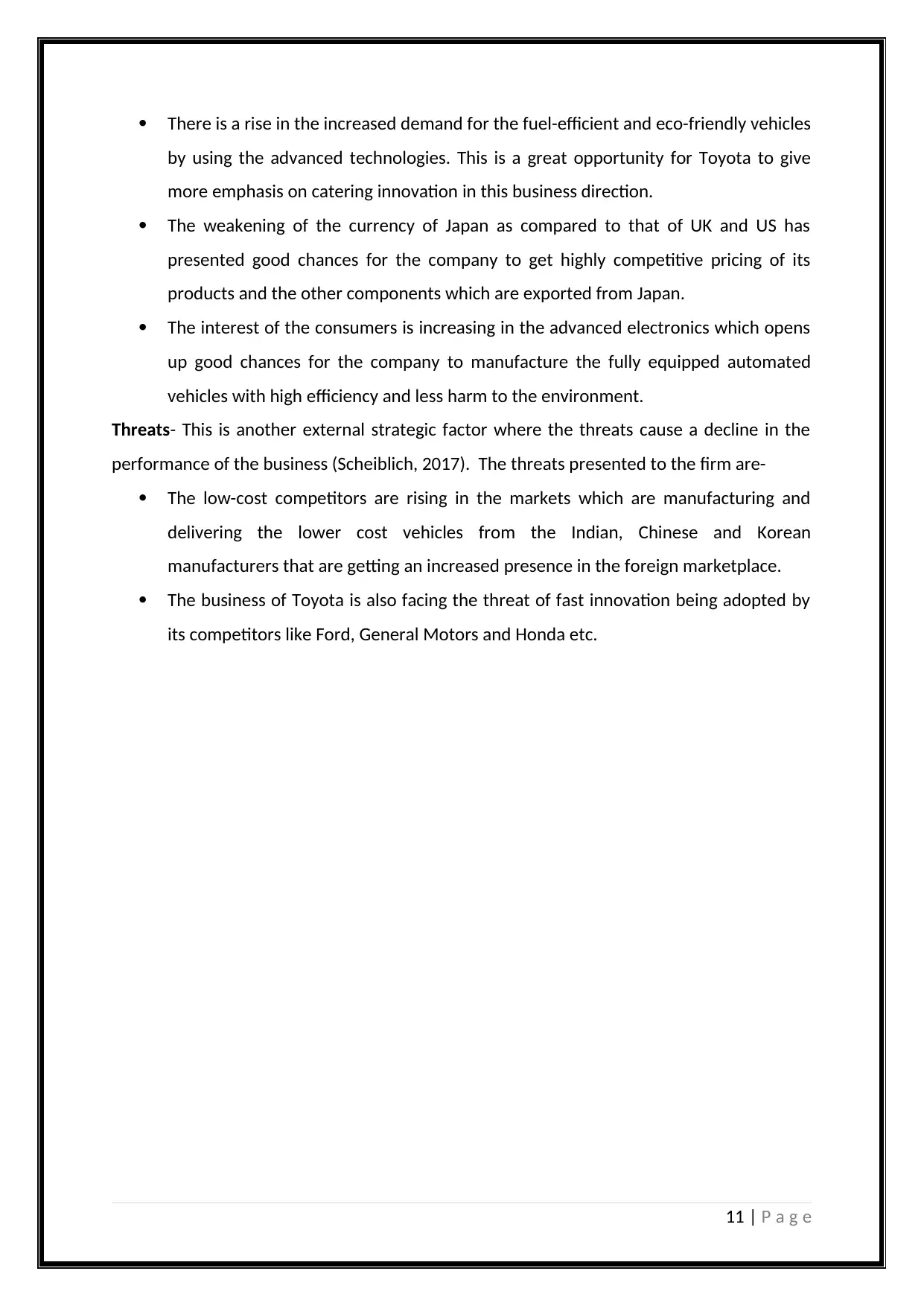
There is a rise in the increased demand for the fuel-efficient and eco-friendly vehicles
by using the advanced technologies. This is a great opportunity for Toyota to give
more emphasis on catering innovation in this business direction.
The weakening of the currency of Japan as compared to that of UK and US has
presented good chances for the company to get highly competitive pricing of its
products and the other components which are exported from Japan.
The interest of the consumers is increasing in the advanced electronics which opens
up good chances for the company to manufacture the fully equipped automated
vehicles with high efficiency and less harm to the environment.
Threats- This is another external strategic factor where the threats cause a decline in the
performance of the business (Scheiblich, 2017). The threats presented to the firm are-
The low-cost competitors are rising in the markets which are manufacturing and
delivering the lower cost vehicles from the Indian, Chinese and Korean
manufacturers that are getting an increased presence in the foreign marketplace.
The business of Toyota is also facing the threat of fast innovation being adopted by
its competitors like Ford, General Motors and Honda etc.
11 | P a g e
by using the advanced technologies. This is a great opportunity for Toyota to give
more emphasis on catering innovation in this business direction.
The weakening of the currency of Japan as compared to that of UK and US has
presented good chances for the company to get highly competitive pricing of its
products and the other components which are exported from Japan.
The interest of the consumers is increasing in the advanced electronics which opens
up good chances for the company to manufacture the fully equipped automated
vehicles with high efficiency and less harm to the environment.
Threats- This is another external strategic factor where the threats cause a decline in the
performance of the business (Scheiblich, 2017). The threats presented to the firm are-
The low-cost competitors are rising in the markets which are manufacturing and
delivering the lower cost vehicles from the Indian, Chinese and Korean
manufacturers that are getting an increased presence in the foreign marketplace.
The business of Toyota is also facing the threat of fast innovation being adopted by
its competitors like Ford, General Motors and Honda etc.
11 | P a g e
⊘ This is a preview!⊘
Do you want full access?
Subscribe today to unlock all pages.

Trusted by 1+ million students worldwide
1 out of 16
Related Documents
Your All-in-One AI-Powered Toolkit for Academic Success.
+13062052269
info@desklib.com
Available 24*7 on WhatsApp / Email
![[object Object]](/_next/static/media/star-bottom.7253800d.svg)
Unlock your academic potential
Copyright © 2020–2025 A2Z Services. All Rights Reserved. Developed and managed by ZUCOL.





